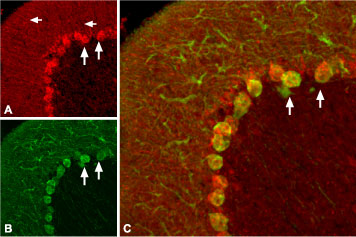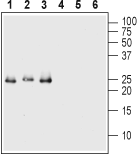Overview
Cat #: BLP-NT006
Type: Synthetic peptide
Form: Lyophilized powder
proBDNF Blocking Peptide (#BLP-NT006) is the original antigen used for immunization during Anti-proBDNF Antibody (#ANT-006) generation. The blocking peptide binds and ‘blocks’ Anti-proBDNF primary antibody, this makes it a good negative reagent control to help confirm antibody specificity in western blot and immunohistochemistry applications. This control is also often called a pre-adsorption control.
Applications: wb, ihc
Application key:
WB- Western blot, IHC- Immunohistochemistry
For research purposes only. not for human use
Applications
Demonstration of Pre-adsorption control
 Western blot analysis of rat glioma C6 (1, 3) or human neuroblastoma SH-SY5Y (2, 4) cell lysate:1,2. Anti-proBDNF Antibody (#ANT-006), (1:200).
Western blot analysis of rat glioma C6 (1, 3) or human neuroblastoma SH-SY5Y (2, 4) cell lysate:1,2. Anti-proBDNF Antibody (#ANT-006), (1:200).
3,4. Anti-proBDNF Antibody, preincubated with proBDNF Blocking Peptide (#BLP-NT006). Western blot analysis using Anti-proBDNF Antibody (#ANT-006), (1:400):1. Recombinant human proBDNF protein (#B-257), (20 ng).
Western blot analysis using Anti-proBDNF Antibody (#ANT-006), (1:400):1. Recombinant human proBDNF protein (#B-257), (20 ng).
2. Recombinant human proNGF protein (#N-280), (200 ng).
3. Recombinant proNT-3 (200 ng).
4. Recombinant human BDNF protein (#B-250), (200 ng).
5. Native mouse NGF 2.5S protein (>95%) (#N-100), (200 ng).
6. Recombinant human Neurotrophin-3 (NT-3) protein (#N-260), (200 ng). Expression of proBDNF in rat cerebellumImmunohistochemical staining of rat cerebellum with Anti-proBDNF Antibody (#ANT-006). proBDNF (red) appears in Purkinje cell bodies (vertical arrows) and in astrocytic processes (horizontal arrows in A) but not in Purkinje neuronal dendrites stained for calbindin D28k (green, in B) in the same brain section. C. Confocal merge of proBDNF and CBD28K demonstrates the restriction of proBDNF to Purkinje cell body.
Expression of proBDNF in rat cerebellumImmunohistochemical staining of rat cerebellum with Anti-proBDNF Antibody (#ANT-006). proBDNF (red) appears in Purkinje cell bodies (vertical arrows) and in astrocytic processes (horizontal arrows in A) but not in Purkinje neuronal dendrites stained for calbindin D28k (green, in B) in the same brain section. C. Confocal merge of proBDNF and CBD28K demonstrates the restriction of proBDNF to Purkinje cell body. Multiplex staining of BDNF and proBDNF in rat hippocampusImmunohistochemical staining of rat hippocampal dentate gyrus perfusion-fixed frozen sections using Guinea pig Anti-BDNF Antibody (#ANT-010-GP), (1:300) and Anti-proBDNF Antibody (#ANT-006), (1:200). A. BDNF staining (red) appears in interneuron outlines (arrows) in the hilus (H) region and in the granule layer (G). B. proBDNF staining (green) in the same section appears in interneuron outlines (arrows) in the hilus (H) region and in the granule layer (G). C. Merge of panel A and panel B shows extensive co-localization of the two proteins.
Multiplex staining of BDNF and proBDNF in rat hippocampusImmunohistochemical staining of rat hippocampal dentate gyrus perfusion-fixed frozen sections using Guinea pig Anti-BDNF Antibody (#ANT-010-GP), (1:300) and Anti-proBDNF Antibody (#ANT-006), (1:200). A. BDNF staining (red) appears in interneuron outlines (arrows) in the hilus (H) region and in the granule layer (G). B. proBDNF staining (green) in the same section appears in interneuron outlines (arrows) in the hilus (H) region and in the granule layer (G). C. Merge of panel A and panel B shows extensive co-localization of the two proteins. Western blot analysis of 50 ng of each Recombinant human Val66Met proBDNF (cleavage resistant) protein (#B-456) (lanes 1 and 4), Recombinant mouse proBDNF protein (#B-240) (lanes 2 and 5) and Recombinant human proBDNF protein (#B-257) (lanes 3 and 6):1-3. Guinea pig Anti-proBDNF Antibody (#ANT-006-GP), (1:200).
Western blot analysis of 50 ng of each Recombinant human Val66Met proBDNF (cleavage resistant) protein (#B-456) (lanes 1 and 4), Recombinant mouse proBDNF protein (#B-240) (lanes 2 and 5) and Recombinant human proBDNF protein (#B-257) (lanes 3 and 6):1-3. Guinea pig Anti-proBDNF Antibody (#ANT-006-GP), (1:200).
4-6. Guinea pig Anti-proBDNF Antibody, preincubated with proBDNF Blocking Peptide (#BLP-NT006). Expression of proBDNF in rat spinal cordImmunohistochemical staining of immersion-fixed, free floating rat spinal cord frozen sections using Guinea pig Anti-proBDNF Antibody (#ANT-006-GP), (1:1000). proBDNF (red) is detected in the superficial layer (arrow) of the dorsal horn of the spinal cord. The myelinated columns are devoid of staining. Cell nuclei are stained with DAPI (blue).
Expression of proBDNF in rat spinal cordImmunohistochemical staining of immersion-fixed, free floating rat spinal cord frozen sections using Guinea pig Anti-proBDNF Antibody (#ANT-006-GP), (1:1000). proBDNF (red) is detected in the superficial layer (arrow) of the dorsal horn of the spinal cord. The myelinated columns are devoid of staining. Cell nuclei are stained with DAPI (blue).
Properties
Sequence
Accession (Uniprot) Number P23560
Peptide Confirmation Confirmed by amino acid analysis and mass spectrometry.
Purity >70%
Storage Before Reconstitution Lyophilized powder can be stored intact at room temperature for two weeks. For longer periods, it should be stored at -20°C.
Reconstitution 100 µl double distilled water (DDW).
Storage After Reconstitution -20°C.
Antigen Preadsorption Control 1 μg peptide per 1 μg antibody.
Standard Quality Control Of Each Lot Western blot analysis.

